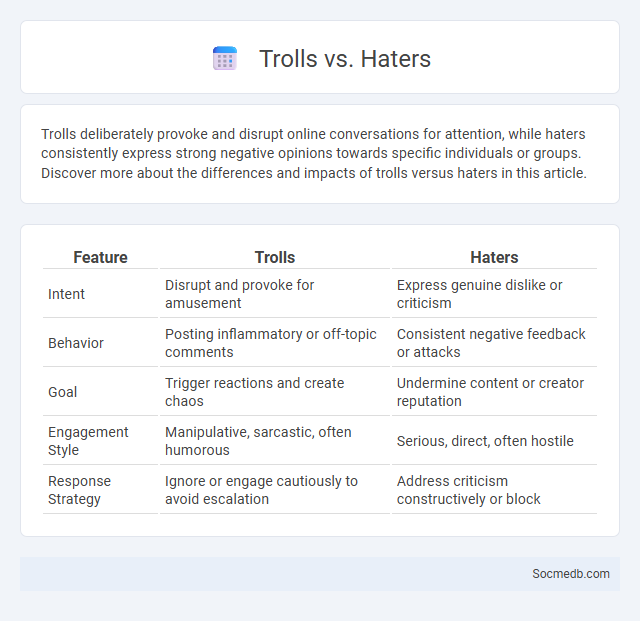
Photo illustration: Trolls vs Haters
Trolls deliberately provoke and disrupt online conversations for attention, while haters consistently express strong negative opinions towards specific individuals or groups. Discover more about the differences and impacts of trolls versus haters in this article.
Table of Comparison
| Feature | Trolls | Haters |
|---|---|---|
| Intent | Disrupt and provoke for amusement | Express genuine dislike or criticism |
| Behavior | Posting inflammatory or off-topic comments | Consistent negative feedback or attacks |
| Goal | Trigger reactions and create chaos | Undermine content or creator reputation |
| Engagement Style | Manipulative, sarcastic, often humorous | Serious, direct, often hostile |
| Response Strategy | Ignore or engage cautiously to avoid escalation | Address criticism constructively or block |
Understanding the Differences: Trolls vs Haters
Trolls intentionally provoke and disrupt online conversations by posting inflammatory or off-topic messages to elicit strong reactions, while haters express genuine dislike or criticism towards a person, brand, or idea. Recognizing the difference between trolls and haters is essential for effective social media management, as trolls seek attention through chaos whereas haters often reflect authentic negative opinions. Strategies for handling trolls typically involve ignoring or blocking, whereas addressing haters may require engaging constructively or improving the criticized aspect.
The Psychology Behind Trolling
Trolling exploits psychological triggers such as anonymity, social validation, and the desire for power or attention, which amplify disruptive online behavior. Understanding cognitive biases like the online disinhibition effect helps explain why individuals engage in trolling despite potential social consequences. By recognizing these psychological factors, you can better navigate social media interactions and mitigate the impact of toxic digital communication.
What Drives Online Hate?
Online hate is driven primarily by anonymity, which allows individuals to express negativity without immediate personal consequences. Social media algorithms amplify divisive content by promoting engagement, often prioritizing controversial posts that generate strong emotional reactions. Your exposure to online hate increases as echo chambers reinforce biased viewpoints, fueling further hostility and polarization.
Common Tactics Used by Trolls
Trolls commonly employ tactics such as spreading misinformation, posting inflammatory comments, and hijacking conversations to provoke emotional responses and disrupt online communities. They often use fake profiles or anonymity to evade accountability and amplify divisive content across social media platforms like Twitter, Facebook, and Reddit. These strategies exploit algorithmic biases, increasing the visibility of controversial posts and escalating conflicts within digital spaces.
Identifying Haters: Signs and Characteristics
Haters often leave negative comments that are personal, aggressive, and repetitive, aiming to provoke emotional reactions. You can identify them by patterns such as consistent criticism without constructive feedback, anonymity, and use of exaggerated language or insults. Recognizing these signs helps in managing your social media environment and maintaining a positive online experience.
How Trolls and Haters Impact Online Communities
Trolls and haters disrupt online communities by spreading negativity, provoking conflicts, and causing emotional distress among members. Their toxic behavior undermines trust and discourages genuine engagement, leading to decreased participation and community fragmentation. Protecting Your digital spaces requires effective moderation and fostering respectful communication to maintain a healthy online environment.
Strategies to Deal with Trolls
Effective strategies to deal with social media trolls include implementing strict moderation policies, utilizing automated filters to detect harmful language, and fostering a positive community culture through clear guidelines. Engaging selectively by responding calmly to constructive criticism while ignoring inflammatory comments minimizes escalation and reduces troll influence. Leveraging platform tools such as blocking, muting, and reporting also helps maintain a healthy online environment and protects users from harassment.
Addressing Hateful Comments Effectively
Addressing hateful comments effectively requires a clear strategy that prioritizes your mental well-being and community standards. Use platform tools like reporting, blocking, and filtering to manage toxic interactions while maintaining constructive dialogue with genuine users. Your prompt, calm responses combined with firm boundaries can de-escalate negativity and foster a positive online environment.
Preventing Trolls and Haters in Your Digital Space
Implementing strict moderation policies and utilizing AI-powered tools can effectively identify and block trolls and haters in your digital space. Encouraging a positive community culture through clear guidelines and prompt responses to harmful behavior reduces toxic interactions. Your proactive approach fosters a safer, more engaging social media environment for all users.
Fostering a Positive Online Environment
Creating a positive online environment on social media platforms involves promoting respectful communication and actively discouraging harassment or hate speech through community guidelines and effective moderation tools. Encouraging users to share uplifting content and support diverse perspectives helps build inclusive digital spaces that enhance mental well-being. Platforms like Facebook, Twitter, and Instagram implement AI-driven algorithms to detect harmful behavior and foster constructive interactions among users.
 socmedb.com
socmedb.com